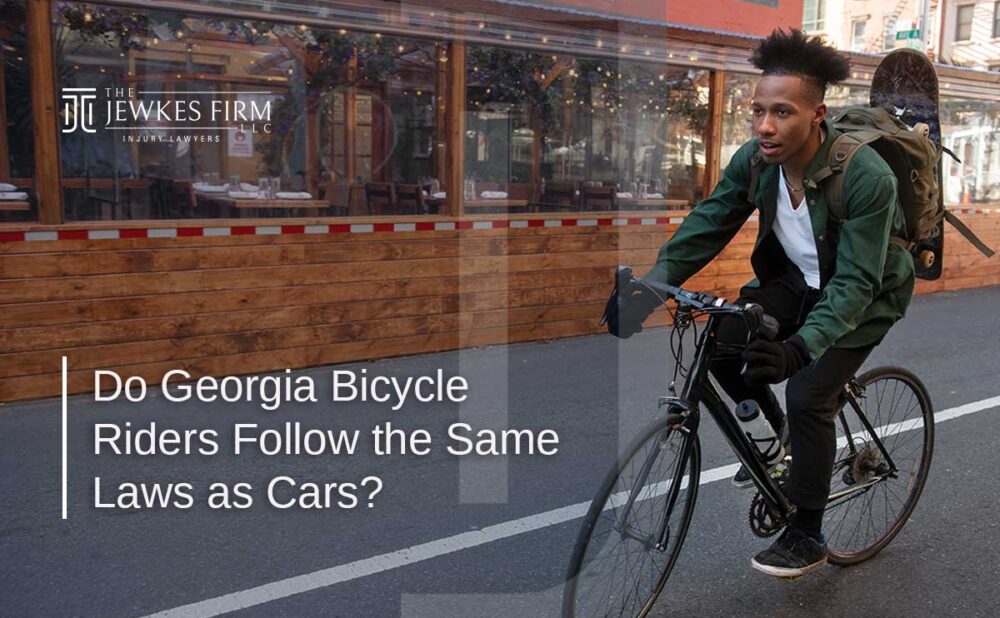Do Georgia Bicycle Riders Follow the Same Laws as Cars?
In Georgia, cyclists are not just recreation riders — they’re drivers under the law and must adhere to the majority of the same traffic rules as motorists, with a few specific exceptions. As the popularity of cycling continues to rise in Georgia, understanding the traffic laws that apply to bicycle riders is crucial for ensuring safety and compliance. In this article, we will explore whether bicycle riders in Georgia must follow the same traffic laws as motor vehicles, the specific regulations that apply to cyclists, and the implications for personal injury cases.
At The Jewkes Firm, bicycle accident attorney Jordan Jewkes understands the importance of knowing your rights and duties on the road.
Hurt While Riding Your Bike? Contact Us For A Free Consultation
Hurt While Riding Your Bike?
The Legal Framework for Bicycle Riders in Georgia
Under Georgia law, bicycles are officially defined as a “vehicle”, not specifically a “motor vehicle.” According to O.C.G.A. § 40-1-1, a bicycle is a device propelled by human power upon which any person may ride. This classification subjects cyclists to core traffic rules outlined in the Georgia Code, while distinguishing them from motor vehicles in areas like licensing and registration.
Core Traffic Rules Apply
Bicyclists typically adhere to the same traffic regulations as motor vehicle drivers. Authorities do not require them to have a driver’s license.
It’s important for both cyclists and motorists to be aware of these laws to ensure safety on the roads. Cyclists must obey laws that universally apply to all vehicles including:
- Right-of‑way and lane usage. Ride on the right as close as safely possible unless turning left, avoiding hazards, matching traffic speed, or navigating a narrow lane.
- Lane occupancy. Two cyclists may ride abreast only in bike lanes, paths, or specially designated events.
- Stop signs and signals. Must come to a complete stop at red lights, stop signs, and other traffic signals.
- Hand signals. Left arm extended horizontally for left turns; after 2011 law update, right arm extended or left arm pointing up for right turns.
- No “cling‑on” riding. Cyclists can’t attach themselves to motor vehicles.
- No overloading. A bike can only carry one passenger unless it is built for more.
Key Traffic Laws for Bicycle Riders
- Obeying Traffic Rules. Bicyclists must obey all traffic signs, signals, and lane markings, just like drivers of motor vehicles. They are also required to ride in the same direction as traffic and use hand signals when turning or stopping.
- Riding in the Same Direction. Bicyclists must ride in the same direction as traffic. Riding against traffic is not only illegal but also significantly increases the risk of accidents.
- Use of Bike Lanes. Cyclists should use designated bike lanes when available. If a bike lane is not present, cyclists are permitted to ride on the roadway but must stay as far to the right as practicable, except when passing another vehicle or preparing for a left turn.
- Equipment Requirements. Georgia law mandates that bicycles have certain safety features. For instance, cyclists must have a white front light and a red rear light or reflector when riding at night. Helmets are not legally required for adults but are highly recommended for safety.
- No Riding on Sidewalks. Riding on sidewalks is generally prohibited for individuals over the age of 12, unless a local ordinance allows it. Cyclists should check local laws to understand where they can legally ride.
- Yielding to Pedestrians. Cyclists must yield the right-of-way to pedestrians in crosswalks and should always be cautious when passing pedestrians on shared paths.
- Three-Foot Passing Law. Motorists must provide cyclists with at least three feet of space when passing. If a lane change is not possible, drivers must reduce their speed to at least 10 mph below the posted speed limit or 25 mph, whichever is greater, and proceed around the bicycle with at least three feet of clearance.
- Electric Bicycles. Electric-assisted bicycles are subject to the same laws as traditional bicycles, with some additional regulations regarding their operation.
Bike-Specific Rules
Georgia law also includes several cycling-specific regulations:
- Helmet law. Riders and passengers under 16 must wear an ANSI or Snell–approved helmet.
- Lighting and reflectors. At night, bikes must have a white front light and a rear red light or reflector visible from 300 feet.
- Proper seat and handlebars. Riding only on a standard bicycle seat; handlebars cannot force hands above shoulder level.
- One-hand requirement. Riders must always have at least one hand on the handlebars.
- Child safety rules. No children under 1 year on the main bike frame; over-1-year-old children must use a sling, child seat, or trailer as per manufacturer’s instructions.
The Importance of Following Traffic Laws
Adhering to traffic laws is not just a matter of legal compliance; it is also essential for the safety of cyclists and others on the road. Failure to follow these laws can lead to accidents, injuries, and even fatalities. Moreover, if a cyclist gets in an accident and is found to be in violation of traffic laws, it may impact their ability to recover damages in a personal injury claim.
Bicycle Accident Statistics in Georgia
Bicycle accidents in Georgia pose significant risks to cyclists, with numerous incidents resulting in serious injuries and fatalities. Understanding the legal implications and statistics surrounding these accidents is crucial for both cyclists and motorists.
Recent data highlights the severity of bicycle accidents in Georgia:
- Fatalities. In 2022, there were 29 bicyclist fatalities in Georgia, marking an increase from previous years.
- Injuries. Motor vehicle traffic and non-traffic-related crashes injured approximately 400 bicyclists in 2022.
- High-Risk Areas. Urban counties outside the Atlanta region report the highest crash rates.
- Intersection Incidents. Over 50% of bicycle crashes occur at intersections.
- Helmet Usage. Between 2019 and 2022, 64% of fatally injured cyclists were not wearing helmets.
Safety Tips for Cyclists
To reduce the risk of accidents:
- Helmet Use. All persons under the age of 16 must wear a properly fastened helmet when they ride a bicycle.
- Lighting and Reflectors. Equip bicycles with a white front light visible from at least 300 feet and a red rear reflector or light visible from at least 300 feet when in use at nighttime.
- Obey Traffic Laws. Ride in the direction of traffic flow and adhere to all traffic control signals.
- Be Visible. Wear bright or reflective clothing.
- Stay Alert. Avoid distractions and be aware of your surroundings.
Understanding the statistics and legal aspects of bicycle accidents in Georgia is essential for ensuring safety and pursuing rightful compensation. By adhering to traffic laws and taking necessary precautions, cyclists can mitigate risks and contribute to safer roadways.

GEORGIA PERSONAL INJURY LAWYER NEAR ME
Implications for Personal Injury Cases
In the unfortunate event of a bicycle accident, understanding the legal responsibilities of both cyclists and motor vehicle operators is crucial. If a cyclist gets hurt due to the negligence of a motorist, they may have grounds for a personal injury claim. However, if the cyclist was not following traffic laws at the time of the accident, this could complicate their case.
Establishing Fault and Compliance
If a cyclist obeys traffic laws — stops, signals, stays right — this bolsters their credibility. Conversely, violating these laws (e.g., running stop signs, no signal) might diminish recovery.
Determining Liability of Drivers
When drivers violate laws like the 3‑foot rule, fail to yield in bike lanes, or turn without checking, they may face traffic citations and civil liability.
Equipment Defects and Bike-Specific Violations
Defective lights or brakes, or not wearing helmets (for under-16s), can influence damages or liability under product liability, premises, or comparative negligence doctrines.
Comparative Negligence in Georgia
Georgia follows a modified comparative negligence system. Injured cyclists found more than 50% at fault may be barred from recovery; less than 50% at fault reduces compensation proportionally. For example, if a cyclist was riding against traffic and was involved in a collision, their compensation could be significantly affected if the court finds them partially responsible.
Pursuing Compensation After a Bike Accident
Accidents often result from driver negligence, including improper lane changes, failure to yield, and tailgating. Injuries range from minor to severe, with settlements varying accordingly. For instance, spinal cord injuries can lead to six-figure settlements due to extensive medical care. Bicycle accident victims may receive compensation for:
- Medical Expenses. Including hospital bills, rehabilitation, and future medical costs.
- Lost Wages. For time off work to injury.
- Pain and Suffering. For physical and emotional distress.
- Property Damage. To repair or replace damaged bicycles.
Consulting with an experienced personal injury attorney can help navigate the legal process and ensure fair compensation.
How The Jewkes Firm Can Help
If you’ve been injured in a bicycle accident, Attorney Jordan Jewkes can:
- Review police reports and verify legal violations (by driver or cyclist)
- Analyze bike equipment (lights, brakes, helmets) in insurance claims
- Apply Georgia’s comparative negligence rules to maximize your recovery
- Advocate for you through settlement negotiations or court
Your safety and legal rights are paramount. If you or a loved one has been hurt while cycling in Georgia, you deserve aggressive representation — Jordan Jewkes and The Jewkes Firm are ready to stand by your side.
Bottom Line
Yes — Georgia cyclists must follow most of the same traffic laws as motorists. Understanding these rules strengthens your rights on the road and your position in insurance or personal injury claims. For guidance tailored to your situation, contact The Jewkes Firm today at (770) 771-5130 for a free consultation.
Frequently Asked Questions
Do bicycle riders in Georgia have to follow the same traffic laws as motor vehicles?
Yes, Georgia considers bicycles vehicles under the law. Bike riders must follow many of the same traffic laws as motor vehicles. Cyclists must obey traffic signals, ride in the same direction as traffic, use bike lanes when available, and yield to pedestrians. They are also required to have specific safety equipment when riding at night.
Can bicyclists ride on the sidewalk in Georgia?
Riding on sidewalks is generally prohibited unless local ordinances specifically allow it. Cyclists should check local laws to understand where they can legally ride.
Are helmets required for bicycle riders in Georgia?
Helmets are mandatory for riders and passengers under 16 years old. While helmets are not legally required for adults in Georgia, they are highly recommended for safety.
What is Georgia's 3-foot passing law?
Drivers must leave at least 3 feet of clearance when passing a cyclist or change lanes. Violations may lead to traffic tickets or civil liability.
What happens if a cyclist gets in an accident while violating traffic laws?
If a cyclist is found to be at fault for violating traffic laws during an accident, it may affect their ability to recover damages in a personal injury claim due to Georgia's modified comparative negligence rule.




